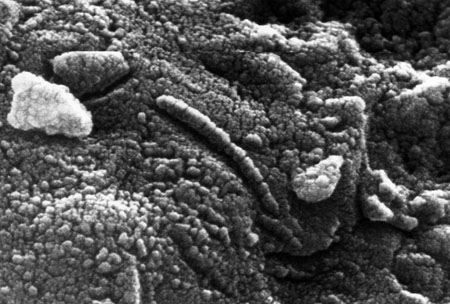Life Everywhere NASA Looks?
June 17, 2010
As far as we know, Earth is the only place in the universe where life exists. Of course, we've only started our search. The search for intelligent life in the universe started in 1960 with
Project Ozma, an attempt to detect radio signals from the vicinity of two nearby stars,
Tau Ceti and
Epsilon Eridani.
Frank Drake, who conducted the search using the 85 foot dish antenna at the
National Radio Astronomy Observatory at
Green Bank, West Virginia, looked at frequencies near 1.420 gigahertz, the hydrogen emission line at microwave frequencies. This was considered to be a likely place to search, since hydrogen is the most abundant element in the universe, and the radio noise level is reasonably low near that frequency. No interstellar communication signals were found, but the
search continues.
Of course, intelligent life is a very small subset of life, itself.
Bacteria can't communicate, but there are about
70,000 species of bacteria on Earth. For most of
Earth's history, intelligent humans did not exist, but the Earth was resplendent with other organisms. NASA has been using spacecraft to search for simple lifeforms of our Solar System since the 1970s. Everywhere NASA looks, someone thinks that the data indicate that present or fossil life has been found.
The first such instance was in 1976, when the
Viking Landers landed on Mars. These landers were designed to scoop up soil samples and test them for biological activity. No organic compounds were detected in the soil, but an experiment to detect metabolism gave a positive result. It appears that this was a false positive caused by the oxidizing nature of Martian soil, which contains
perchlorate salts.
Then, there was the discovery of fossil microbes in a Martian meteorite,
ALH84001, found in Antarctica in December 1984. It may be surprising, but it's quite certain that this meteorite and others of its type did originate from Mars. These
Shergottites, Nakhlites, Chassignites-type meteorites were blasted from the Martian surface millions of years ago, and some have ended up on Earth. The conditions at Antarctica preserved ALH84001 and made it easy to find. A NASA team found bacteria-like structures in the meteorite, and they also found
magnetite crystals of the
type associated with biological activity on Earth, although many scientists are skeptical. As late as November 2009, NASA scientists have said that subsequent examination of this meteorite shows "strong evidence that life may have existed on ancient Mars." [3]

Microbe-like structure in ALH84001
Moving away from Mars to Saturn's moon,
Titan, NASA's
Cassini spacecraft has detected a paucity of both
acetylene and
hydrogen on Titan. Titan can't support Earth-like organisms. There is no liquid water on Titan, since the temperature is only 90 Kelvin, but rather lakes of
methane and
ethane. However, an exotic lifeform in such lakes could metabolize acetylene and hydrogen to create methane. [4,5] So, what do some scientists conclude? Life! Who would have guessed? However, level heads do still prevail. Mark Allen of NASA's
Jet Propulsion Laboratory says "Scientific conservatism suggests that a biological explanation should be the last choice after all non-biological explanations are addressed. We have a lot of work to do to rule out possible non-biological explanations. It is more likely that a chemical process, without biology, can explain these results - for example, reactions involving mineral
catalysts." [5] The
Titan Mare Explorer, is a proposed mission to do a more thorough analysis [6].
References:
- Viking Program on Wikipedia.
- ALH84001 meteorite on Wikipedia.
- William P. Jeffs, "New Study Adds to Finding of Ancient Life Signs in Mars Meteorite," (NASA Press Release J09-030, November 30, 2009).
- David Shiga, "Hints of life found on Saturn moon," New Scientist Online (June 4, 2010).
- Jia-Rui Cook and Cathy Weselby, "What is Consuming Hydrogen and Acetylene on Titan?" (NASA Press Release 2010-190, June 3, 2010).
- Rachel Courtland, "Life on Titan? Maybe – but only a lander will tell us," New Scientist Online (June 10, 2010).
Permanent Link to this article